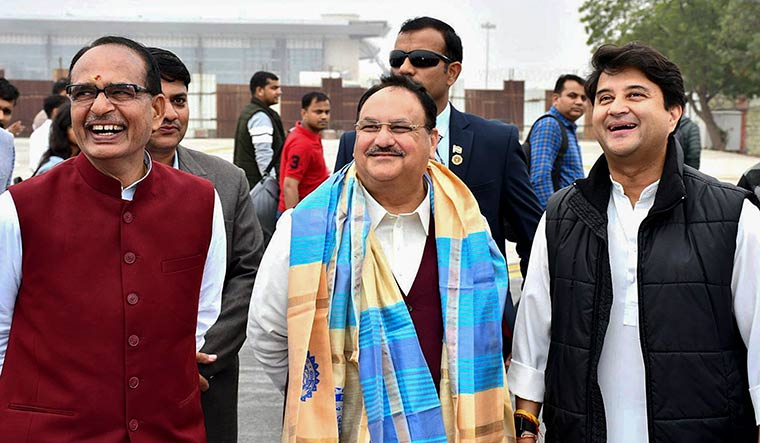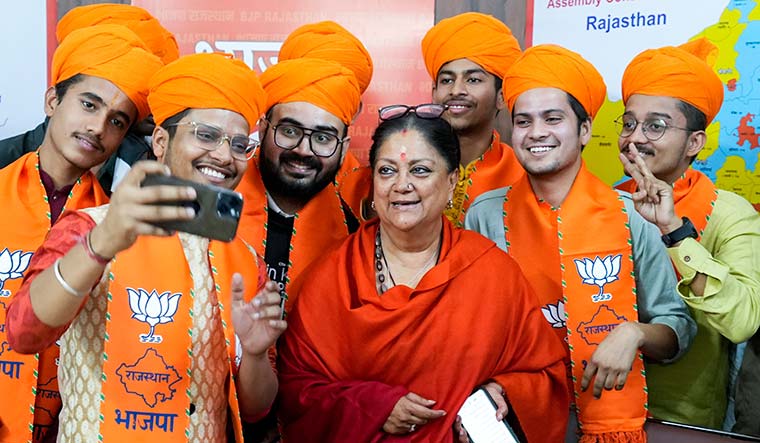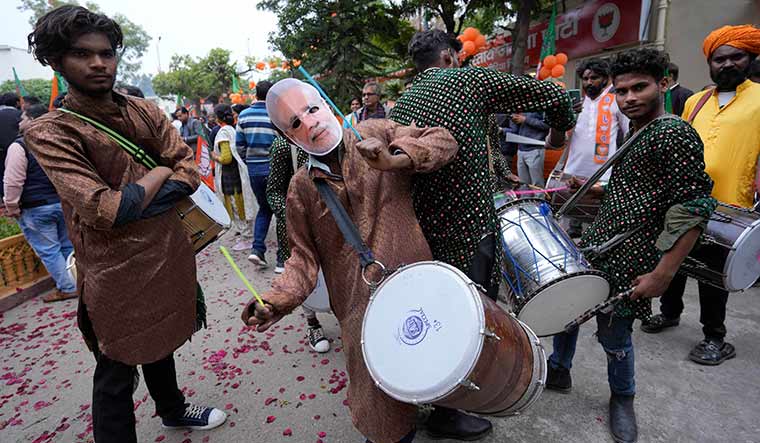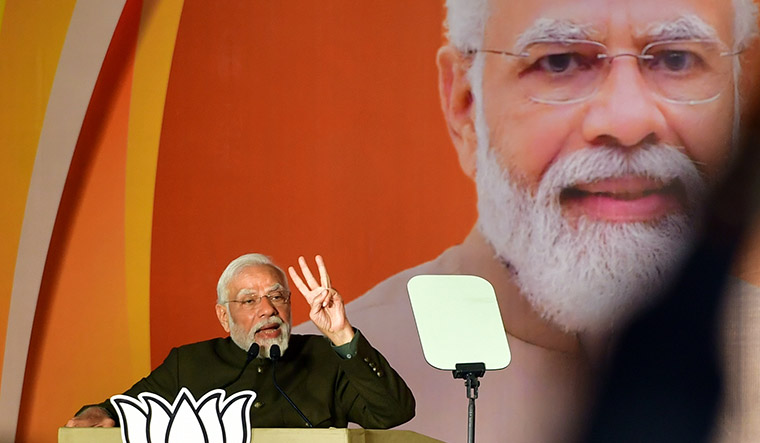On November 17, the day Madhya Pradesh went to the polls, cellphones of the BJP’s local functionaries rang at 5am.
It was Brahma Muhurta, an auspicious time to start the day. The first wakeup call from the party’s state unit alerted the functionaries to the busy day ahead. Sunrise was still 90 minutes away, and chances were that some could have hit the snooze button. A voice message was sent on WhatsApp to reinforce the alert. To rule out chances of non-delivery of the message, a third call was made from the party’s call centre.
All those who mattered in each district―the party president, the booth management coordinator, constituency chiefs, polling agents and booth presidents―were thus woken up. By 6am, provisions were made to ensure that party workers across the state were out on the streets to escort voters to booths and carry out other tasks. The operations were meticulous. For more than a year, cadres had undergone training according to a 15-point programme prepared by Union Home Minister Amit Shah.
When votes were finally counted on December 3, the BJP got more than 48 per cent votes. The party bagged 50 lakh more votes than in 2018, while the Congress, which was supposed to have benefited from anti-incumbency, could manage only 15 lakh more votes. The BJP’s planning had made all the difference.
The election machinery that the party had perfected in Gujarat was replicated across three Hindi heartland states―Madhya Pradesh, Rajasthan and Chhattisgarh. Electoral arithmetic, combined with Prime Minister Narendra Modi’s connect with voters, and the support that Madhya Pradesh Chief Minister Shivraj Singh Chouhan received from women beneficiaries of his social welfare schemes, trumped the “vote for change” sentiment that had existed in the months leading to the polls.
Similar performances in Rajasthan and Chhattisgarh, and an improved vote share in Telangana, mean that Prime Minister Modi starts his 2024 bid for a third term in office on a high note. The party had turned this round of assembly elections as a referendum on Modi. For the Congress-led opposition group INDIA, the signs are ominous. Its trump cards of caste census, reinstating the old pension scheme, and guarantees for women, youth and farmers fell terribly short.
 Triumphant trio: (From left) Madhya Pradesh Chief Minister Shivraj Singh Chouhan, BJP national president J.P. Nadda and Union Minister Jyotiraditya Scindia | PTI
Triumphant trio: (From left) Madhya Pradesh Chief Minister Shivraj Singh Chouhan, BJP national president J.P. Nadda and Union Minister Jyotiraditya Scindia | PTI
“The credit for the victories in Rajasthan, Madhya Pradesh and Chhattisgarh goes to Prime Minister Modi,” said Nitin Patel, the BJP’s joint in-charge for Rajasthan and former Gujarat deputy chief minister. “His name, his face, his image, his credibility and his global acceptance have worked. The several schemes for the poor in all three states have worked. We will win more Lok Sabha seats than the 303 [won in 2019].”
According to Muralidhar Rao, the BJP’s joint in-charge of Madhya Pradesh, the BJP has been able to expand its support base in three states. “The clear message is that under Shivraj Singh Chouhan in Madhya Pradesh and Modi at the Centre, work done for the poor, especially after Covid, has led to this victory,” he said.
The victories also show how quickly the BJP learnt from its Karnataka defeat. Modi took ownership of the campaign as state leaderships were given equal opportunity under a collective leadership. There were many chief minister aspirants, who were able to motivate voters in their regions of influence. Jyotiraditya Scindia has emerged as a potent force in Madhya Pradesh, as he was able to get the BJP more seats in the crucial Gwalior-Chambal region, his area of influence. In Rajasthan, where Vasundhara Raje has been the tallest BJP leader for 20 years, there is a new crop of leaders in the assembly that includes Baba Balaknath, Diya Kumari and Rajyavardhan Singh Rathore. In Chhattisgarh, the party can choose a new leader to replace former chief minister Raman Singh as its face.
 Party leader Vasundhara Raje with BJP workers | AP
Party leader Vasundhara Raje with BJP workers | AP
The results show that the BJP has been able to cement and expand its core constituency beyond the upper castes. The new addition, apart from tribals, dalits and Other Backward Classes, are women voters who have benefited from Central and state government schemes. The BJP is looking to capture these groups through consistent engagement and messaging through both the government and the party organisation. The strategies include celebrating the contribution of communities, commemorating tribal icons, holding regular meetings of schemes-related beneficiaries and publicising the party’s recent reservation promise.
“The BJP has fought from the front and under the guidance of Prime Minister Modi,” said Rao. “Our ability is not only superior, but also extraordinary. The Congress’s ability to retain power is very weak, as it got exposed in the context of Rajasthan and Chhattisgarh.”
The BJP’s performance in Telangana has not been as good as it had promised, but it had no chance of dislodging the Bharat Rashtra Samithi government on its own. Its visible tactical line was that the focus was on the Lok Sabha polls next year. The BJP had won just one seat in the 2018 assembly polls, but bagged four Lok Sabha seats in 2019. This time, it won eight assembly seats and a vote share of 14 per cent.
 Drumming up the delight: BJP workers celebrating the poll victory in Rajasthan on December 3 | AP
Drumming up the delight: BJP workers celebrating the poll victory in Rajasthan on December 3 | AP
The BJP has not been able to breach the fortresses held by regional parties in southern and eastern states, but it has done well in direct contests with the Congress. In the 2024 Lok Sabha polls, the BJP would have an “ideal and easy” opponent in the Congress in both Telangana and Karnataka, where it had won 25 of 28 Lok Sabha seats last time.
“Our leadership could have done better to counter the Congress propaganda of the BRS and the BJP being together,” said Rao. “But we will do well in Telangana in the future. The BJP will fight the Congress in a much better way than the BRS.”
Of 130 Lok Sabha seats across five southern states, the BJP has 29. The party is finding it difficult to expand in the region. In Tamil Nadu, it has broken off its alliance with the AIADMK and started an aggressive campaign to establish a foothold on its own. A similar plan is being implemented in Punjab, where the BJP had long played second fiddle to its first-ever ally, the Shiromani Akali Dal. The SAD is no longer an ally, so the BJP is happily making inroads into areas where it did not have a presence.
From the longterm perspective, the strategy has its advantages. Before the 2017 assembly polls in Uttar Pradesh, for instance, the party had gone it alone in the local body polls even though it did not have much cadre strength. But the polls helped it establish presence in all villages, which in turn helped it win the subsequent assembly polls.
The latest round of assembly elections has thrown up new facets of the saffron party’s strategy. One, the winnability factor had the party breaking its decade-old unwritten rule of denying tickets to those older than 75 years. Two, the line between freebies and welfarism has been erased. Modi had long been hitting out at the opposition for promising freebies that were a burden on the exchequer. But this round of elections had the BJP bettering each of the Congress’s promises. If the Congress promised LPG cylinders for Rs500 each, the BJP promised it for Rs450. When the Congress in Madhya Pradesh promised a monthly allowance of Rs1,500 to women, the BJP soon started giving women Rs1,250 a month and promised to increase it to Rs3,000. Of 5.26 crore voters in Madhya Pradesh, 2.51 crore are women. More than 1.3 crore women benefited from the women-centric Ladli Laxmi and Ladli Behna schemes.
To counter the INDIA alliance’s trump card of caste census, Modi gave a new slogan of there being only four castes in India―women, the poor, youth and farmers. The BJP formulated its welfarism and messaging to these categories that cover most of the OBCs. And the election results indicate that these “four castes” now listen to Modi.
Neither the Congress nor the regional parties have managed to match the BJP in micromanaging the polls. The polling-day wakeup calls, and taking voters to booths, were the culmination of a year-long preparation that included mapping and digitising data related to workers, functionaries and booths. More than 42,000 WhatsApp groups disseminated the party’s messages to people who cast their votes in 64,523 booths in Madhya Pradesh.
Since February 2022, the BJP has been able to cover as much as 96 per cent of booths in every election. It has been holding training programmes for party workers. In March, the party set up Shakti Kendra teams to strengthen booth-level preparations and social media coordination. Shah had earlier started the panna pramukh system, whereby a person was put in charge of each page of a voter list. For better micromanagement, the BJP has now started appointing half-page pramukhs.
There are now 10,900 Shakti Kendras, of which 85 per cent have half-page pramukhs. Taking cues from management lessons, the BJP in May organised meetings of two to three Shakti Kendras, where team members dined together, played sports and discussed strategies. In the subsequent months, Modi interacted with these grassroots workers who went on a door-to-door campaign to publicise his government’s good work.
In August, the BJP started a missed-call membership drive in Madhya Pradesh. The target given to each worker was to enrol 10 new women, dalits or tribals in the party. The drive received 95 lakh calls, of which 17 lakh were new members. In September, as the poll campaign gathered momentum, each booth-level team was given the task of painting the party symbol and slogan in five places. In subsequent booth-level meetings that were regularly held statewide, workers were handed over lists of beneficiaries of Central and state schemes. Separate lists of voters above 80 and disabled voters who would need assistance to cast their votes were also prepared.
Another innovation was to divide booths in the same way that the party classified assembly constituencies based on the winnability factor. The A-B-C-D categorisation was done on the basis of a perception score of the party’s performance in each booth in the past three elections. This analysis helped the party declare candidates for “difficult seats” much in advance, and bring in Lok Sabha members and Union ministers to lead campaigns in such seats. The BJP’s organisational work can best be summed up using a military adage―the more you sweat in peace, the less you bleed in battle.
Also Read
- Assembly losses force Congress to rework its strategy for LS polls
- BJP next target in MP? 51 per cent vote share in 2024 LS polls
- 'Want to serve people till my last breath': Shivraj Singh Chouhan
- BJP might introduce aggressive governance in Rajasthan. Here's why
- How Revanth Reddy won a battle of personalities against KCR
- Ten reasons the BRS could not score a hat-trick in Telangana
A version of this strategy struck rich dividends in Rajasthan as well. The BJP deputed Shah and party president J.P. Nadda to conduct rallies and meetings in areas where the party was weak. Shah and Nadda’s message―win over 50 per cent votes at the booth level, and win the state as well. An example was the Bharatpur division, where the BJP could win only one of 19 seats in 2018. The Congress had won 13, and eight of the MLAs had become ministers in the Ashok Gehlot government. This time, the BJP’s strong organisational push in Bharatpur helped it win nine seats. Of the 52,000 booths across Rajasthan, the BJP established panels in more than 48,000.
This battle-tested micromanagement at the booth level, where the party’s foot soldiers also chip in, would be replicated in the runup to the 2024 Lok Sabha polls.
As the Lok Sabha polls draw near, the BJP will be preparing promises for each of the 12 states it is in power. It will arrange free train rides for devotees to visit the Ram Temple in Ayodhya―perceived as a key unifying factor for the party’s core constituency in the Hindi heartland. The party may also speed up the process to bring uniform civil codes in states where it is in power. Shah has promised to bring the Citizenship (Amendment) Act out of cold storage.
For the INDIA alliance, the task is cut out―bring greater unity among its constituents and greater coherence in its messaging. Also, bring in those who are currently out of the bloc. Mayawati’s Bahujan Samaj Party, for instance, may have drawn a blank in Madhya Pradesh, but there is a key factor that has been overlooked―the votes polled by the BSP were more than the winning margin in over two dozen seats.


